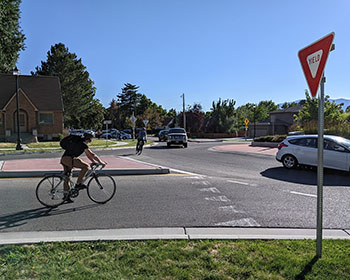

MPC Research Reports |
| Title: | Investigating Bicyclist Safety Perceptions and Behaviors at Roundabouts |
| Authors: | Patrick Singleton and Niranjan Poudel |
| University: | Utah State University |
| Publication Date: | Mar 2024 |
| Report #: | MPC-24-516 |
| Project #: | MPC-603 |
| TRID #: | 01915490 |
| Keywords: | behavior, cyclists, highway design, roundabouts, safety, stated preferences |
 As roundabouts become increasingly popular, and as many communities promote bicycle use, the safety of roundabouts for people bicycling is of major concern. In this project, we studied bicyclists' safety perceptions of and preferences for roundabouts with different characteristics. First, we performed a systematic literature review on bicycle safety at roundabouts, reviewing 49 different resources with empirical findings. Next, we developed a 20-minute online questionnaire to collect data from up to 613 U.S. adult bicyclists. The survey presented respondents with hypothetical roundabouts with various controlled design and operational attributes, represented using text and simulated images. We then analyzed cyclist preferences from a discrete choice experiment and bicycle perceptions of comfort. Overall, U.S. bicyclists prefer roundabouts with smaller central islands, fewer travel lanes, lower traffic volumes, lower speed limits, and separated bicycle lanes. The most comfortable roundabouts for bicycling had many of the same characteristics. Notably, women and "interested but concerned" cyclists had stronger preferences for separated bicycle lanes. We suggest updating U.S. roundabout design guidelines to include "protected roundabouts" allowing these separated bicycle lanes. Considering bicycle preferences and perceived comfort at roundabouts can help encourage cycling for people of all ages and abilities.
As roundabouts become increasingly popular, and as many communities promote bicycle use, the safety of roundabouts for people bicycling is of major concern. In this project, we studied bicyclists' safety perceptions of and preferences for roundabouts with different characteristics. First, we performed a systematic literature review on bicycle safety at roundabouts, reviewing 49 different resources with empirical findings. Next, we developed a 20-minute online questionnaire to collect data from up to 613 U.S. adult bicyclists. The survey presented respondents with hypothetical roundabouts with various controlled design and operational attributes, represented using text and simulated images. We then analyzed cyclist preferences from a discrete choice experiment and bicycle perceptions of comfort. Overall, U.S. bicyclists prefer roundabouts with smaller central islands, fewer travel lanes, lower traffic volumes, lower speed limits, and separated bicycle lanes. The most comfortable roundabouts for bicycling had many of the same characteristics. Notably, women and "interested but concerned" cyclists had stronger preferences for separated bicycle lanes. We suggest updating U.S. roundabout design guidelines to include "protected roundabouts" allowing these separated bicycle lanes. Considering bicycle preferences and perceived comfort at roundabouts can help encourage cycling for people of all ages and abilities.
Singleton, Patrick, and Niranjan Poudel. Investigating Bicyclist Safety Perceptions and Behaviors at Roundabouts, MPC-24-516. North Dakota State University - Upper Great Plains Transportation Institute, Fargo: Mountain-Plains Consortium, 2024.